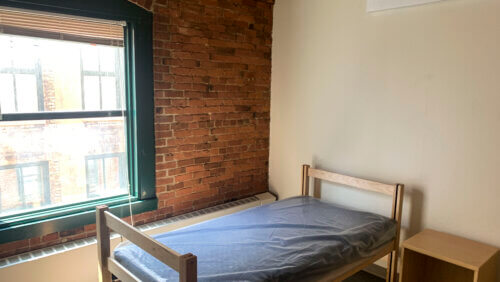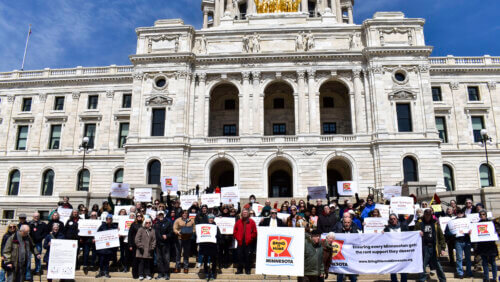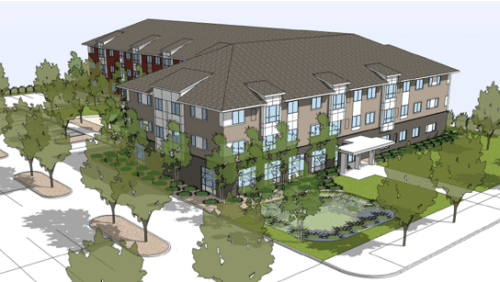How the Housing First service model impacts Beacon residents
The Housing First Series- Part 3. Written by Dylan Novacek, Content Specialist
![]() “Before I found my home, I was tired. For so long, I lived in a system that made it impossible for me to find stability,” Tony said, reflecting on his long journey home. “That all changed when I found American House. Homes like this are important to the community. It helps your neighbors who are down and out.”
“Before I found my home, I was tired. For so long, I lived in a system that made it impossible for me to find stability,” Tony said, reflecting on his long journey home. “That all changed when I found American House. Homes like this are important to the community. It helps your neighbors who are down and out.”
After living outdoors for years, Tony’s time at American House has transformed his life. With over five years of stability under his belt, Tony’s home has provided him with an affordable rent and onsite services which have helped him grow the stability he always hoped for. Living in the same apartment all this time he’s seen neighbors come and go, each with stories similar to his own.
For individuals like Tony, exiting long-term and unsheltered homelessness is met with significant roadblocks. At Beacon Interfaith Housing Collaborative, we work to meet the greatest unmet needs of these community members. Alongside our partners at Avivo, we implement the Housing First model with a Harm Reduction lens at our American House and Kimball Court properties, and soon at Bimosedaa. Through these homes, residents like Tony are given access and choice to be in stable housing that meets their needs.
Unpacking Housing First
“Housing First is an effort to counter-act very large forces,” expressed John Tribbet, Avivo’s Service Area Director. “It’s a necessary model that is at the downstream point of all these negative forces that are excluding residents from the basic safety and security of home.”
Housing First is a housing model with very few barriers to entering permanent housing and services anticipating backgrounds of significant trauma. Coupled with a harm reduction lens where case managers help to mitigate the harm in a resident’s life, ongoing services and supports are offered that connect residents to essential resources. Serving those who are facing the greatest odds because of unjust systems, staff at American House and Kimball Court walk alongside residents to help them find what stability looks like to them.
To learn more about how Housing First is implemented in Beacon homes, click here.
![]() This service model took shape at American House and Kimball Court in 2018 as a response to the emergence of large-scale encampments of people experiencing homelessness in the Twin Cities. Previously, these homes had a small number of units serving those exiting homelessness, with most apartments were affordable to low-income individuals. In an effort to address the community need, Beacon and Avivo collaborated in transforming the service design at these homes.
This service model took shape at American House and Kimball Court in 2018 as a response to the emergence of large-scale encampments of people experiencing homelessness in the Twin Cities. Previously, these homes had a small number of units serving those exiting homelessness, with most apartments were affordable to low-income individuals. In an effort to address the community need, Beacon and Avivo collaborated in transforming the service design at these homes.
For the last five years, these homes have significantly increased their capacity to serve individuals exiting homelessness, primarily directly out of unsheltered homelessness. With this shift, we began serving adults with high levels of vulnerability and trauma due to extended periods of homelessness, mental illness, and substance use disorders.
With collaboration from community partners like Ramsey County and The Red Lake Tribal Nation, American House and Kimball Court have welcomed 285 people into housing since 2019; 173 at American House and 112 at Kimball Court. These are residents who would have otherwise had few, if any, options to enter permanent homes.
Under our Housing First model, residents experience a low-barrier entry into housing. Uniquely, these sites are able to offer same-day move-in’s in some cases. When residents are stably housed, they can begin to work on the things that may have been holding them back. Through a High-Fidelity Harm Reduction service model, all residents at these homes are offered tools needed to reach their goals and build the stability they desire.
Resident Results
![]() “I’ve seen firsthand how this model helps people like me find their footing after experiencing a lifetime of homelessness,” shared John, author and former American House resident.
“I’ve seen firsthand how this model helps people like me find their footing after experiencing a lifetime of homelessness,” shared John, author and former American House resident.
During his 18-month stay in the building, John was able to remain stably housed while also finding access to resources that helped him maintain his sobriety, find employment, and reach his goals. This is just one example of the varied types of success residents have in homes like American House and Kimball Court.
Most residents have been successful in establishing at least one year of housing stability in the program, a significant milestone for someone long accustomed to living on the streets or encampments. Overall, 57% of formerly homeless residents served under this model since 2019 have achieved the at least 1-year milestone of housing stability within the program.
Additionally, most participants take advantage of community resources which help them stabilize their housing and lives. A resounding 90% of participants have been successful in becoming connected to a primary physical or mental health care provider.
“I really don’t think I could’ve gotten this far and remained sober if not for the support I received at American House,” John exclaimed. “As I became stabilized, I found my way into moving into my own home without supports.”
While these successes are worth celebrating, it is also important to note that each resident’s experience coming out of long-term homelessness is unique. For the residents of these homes, American House and Kimball Court can be the first stops on their journey to stability.
Overall, around 20% of exits from these homes are to what is classified by HUD as “safe and stable housing.” Although this is lower than our organization-wide goals and results at non-Housing First sites, our experience is that adapting to living in a permanent home is a challenge for some residents. Some need multiple attempts to achieve this major shift in their view of their life. In some cases, residents find themselves returning to shelter at Avivo Village or to stay with friends or family on a tribal reservation.
American House and Kimball Court keep an open door and we have welcomed back some residents multiple times on their path to a stable home. Wherever people are on their journey home, Beacon and Avivo work to ensure residents are receiving the right services at the right time to best meet their needs.
The Importance of Resident Choice
![]() “When I do outreach work with potential residents living in encampments, I let them know that this home doesn’t have to be their final destination,” shared Avivo’s Brandon Sanford, Program Manager at American House and Kimball Court. “This is a bridge to living indoors. Residents can come and go as they please. Most importantly, we let residents know that being here is their choice.”
“When I do outreach work with potential residents living in encampments, I let them know that this home doesn’t have to be their final destination,” shared Avivo’s Brandon Sanford, Program Manager at American House and Kimball Court. “This is a bridge to living indoors. Residents can come and go as they please. Most importantly, we let residents know that being here is their choice.”
“It’s a matter of having the right opportunity at the right time with the right supports,” added Avivo’s Charlotte Morris, Permanent Supportive Housing Program Director. “We’re guided by the dignity of the person we want to serve. We show up with integrity and offer a place that provides dignity to whoever is in front of us. And they have a choice in all of this.”
Click here to learn more about how we bring residents into housing first.
When providing housing to those with the greatest unmet needs, the realities of this work become apparent. Success isn’t often linear with residents. However, when given simplified access to housing with the services they need, an individual’s journey to the future they desire is made that much easier.
As we continue to learn and grow in this model, we lean on our community partners to help us refine and focus the services to ensure each resident can have a positive, forward-looking experience.
Bringing This Model to Bimosedaa
![]() “It’s the systems our society creates that keeps people living outdoors,” Brandon continued. “But now as we’re having more opportunities in the housing continuum, people who are experiencing long term homelessness are much more willing to come inside.”
“It’s the systems our society creates that keeps people living outdoors,” Brandon continued. “But now as we’re having more opportunities in the housing continuum, people who are experiencing long term homelessness are much more willing to come inside.”
Developed in direct response to the need presented at the Wall of Forgotten Natives in 2018, Bimosedaa will be about 50 apartment homes in downtown Minneapolis. Operating under a similar model to American House and Kimball Court, these homes will uniquely have culturally relevant and responsive on-site services tailored to members of the Native community who are moving out of homelessness.
As previously noted, many who exit the homes at American House and Kimball Court return to encampments. A reason for this is because they find community there. At Bimosedaa we will be partnering with the Red Lake Tribal Nation to ensure that Native individuals can find community in the building and participate in programming that meets their needs.
According to a 2015 report by Wilder Research, Minnesota’s American Indian residents were homeless at 17 times the rate of white Minnesotans. More recently, Wilder’s 2018 Homelessness on American Indian Reservations study found that 74% of American Indians off reservations had been homeless for at least one year or four or more times during the last three years, compared to 63% of people experiencing homelessness who did not identify as American Indian.
Many members of the Native community living in encampments deeply valued the ability to live together to preserve and enrich cultural and community connections.
Creating stable housing where these connections could be maintained was a theme advocates heard over and over again, and lifted up as a key recommendation to provide stability moving forward at Bimosedaa.
Serving a majority BIPOC population at our Beacon homes, the work we’re doing at American House, Kimball Court, and soon at Bimosedaa represents our commitment to be attuned to and meet the needs of residents. With Bimosedaa opening its doors soon, more individuals will have the stability, access, and dignity of home.
The Need for Home
![]() According to research from the City of Saint Paul’s Homeless Action Response Team, there has been a significant rise in unsheltered residents and homeless encampments over the last several years. During the height of the COVID-19 pandemic from 2020-2021, the encampment numbers reached historic levels.
According to research from the City of Saint Paul’s Homeless Action Response Team, there has been a significant rise in unsheltered residents and homeless encampments over the last several years. During the height of the COVID-19 pandemic from 2020-2021, the encampment numbers reached historic levels.
While the homes at American House, Kimball Court, and soon at Bimosedaa stand as a bold response to community need, we also know that we need more homes like them.
Housing First, coupled with a harm reduction lens, addresses the inequities created by our current housing systems. As a community of service providers, housing developers, and advocates, there is a shared need for action as we develop ways to positively impact those living without a home.
“A person can’t change unless you give them the chance,” Tony declared. “My home at American House gave me that chance. I’ve never experienced a home like this in my life. And I am so much happier because of it.”
These homes matter to the community because they give our most at-risk neighbors the choice and access to housing that they didn’t have before. With your support, we can continue to create more homes and offer relevant services to residents. Click here to make a gift today.


